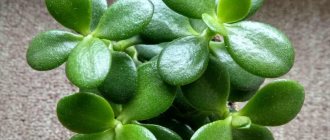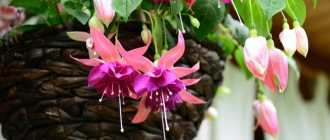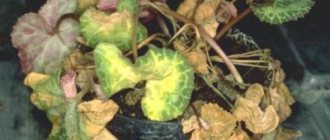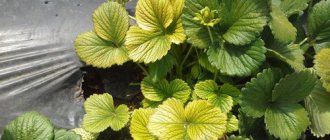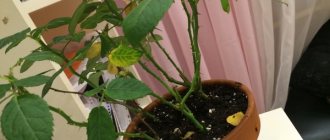Ficus benjamina is an evergreen plant that, under optimal living conditions, should not shed its leaves. Old leaf blades turn yellow and fall off over time, but a large ficus usually does not lose more than 15 leaves per year. On average, each ficus leaf lives up to 3 years .
But if there is massive yellowing of the leaves and their falling off, this indicates the poor condition of the plant. It is necessary to find out the cause and eliminate it as soon as possible.
Ficus leaves can turn yellow and fall off for many reasons. The most common causes of leaf fall: relocation to a new location, draft, sudden drop in temperature, improper replanting, insufficient lighting, improper watering regime and pest damage. Each of these factors can cause complete loss of leaves and sometimes death of the plant.
In this article we will find out why the leaves of ficus Benjamin turn yellow and for what reason they may fall off, and we will also tell you what to do in this situation.
All possible causes and their likelihood
Ficus benjamina has dropped its leaves. What is the reason? Often even experienced gardeners cannot answer this question. To understand why a plant loses its leaves, you need to know what reasons lead to this result most often.
Very often, a plant loses leaves when the temperature drops sharply or in a cold draft . It is the cold draft that matters here if the plant is under air conditioning in the hot summer. In this case, it will definitely shed its leaves. But if the draft is warm, this will not lead to loss of leaf mass.
Also, the plant will respond very quickly to improper watering conditions, damage by pests or infections. Fungal diseases can not only lead to the loss of leaves, but also completely destroy the plant. The same applies to pests. If they are not destroyed, the ficus will die, having shed its leaves first.
With a lack of nutrition, the flower loses its leaves very rarely. Lack of replanting or fertilizing, as well as the use of low-nutrient soils will lead to the loss of only the lower leaves . And a massive loss of greenery occurs when a plant is grown in depleted soil for years.
Lack of light very rarely causes Ficus Benjamin to shed its foliage. This plant does not require light and can grow for a long time in partial shade and even in the shade. Variegated forms may lose color under these conditions. But such lighting does not affect the health of the plant. Ficus plants shed their leaves only when there is a great lack of light. They also react to direct sun during the period after transplantation.
Moving the plant to a new location may cause the leaves to fall. But this only happens if the plant is in poor condition and is infected. Rearranging the pot does not affect the overall well-being of a healthy plant.
Air temperature and humidity
Ficus Benjamin is able to feel good and develop normally at an external temperature of +18-25 degrees. If the air warms up more and this situation lasts long enough, the leaves begin to dry out, turn yellow and fall off.
If the situation is the opposite, and the temperature drops below +18 degrees, the plant also reacts by dropping leaves. This happens when a pot of ficus is placed on a cold windowsill in winter, on a stone or marble floor - this should never be done, especially in winter.
It is also unacceptable to keep the plant in conditions of sudden temperature changes. Ficus Benjamin does not adapt well to new conditions, and if they are changed frequently, serious problems arise. Place the plant in a strictly defined place in the room and do not change its position for as long as possible - only if absolutely necessary. Avoid drafts and keep the ficus away from cold wind from a window or vent.
Humidity
As for the level of humidity, Ficus Benjamin cannot remain in very dry air and high temperatures for a long time. In such conditions, yellowing and dropping of leaves should not be surprising.
In winter, due to working batteries, the air in the apartment is constantly dry. To avoid problems, spray the air around the flower with a spray bottle more often. If you don’t have the desire or time to bother with spraying, you can solve the problem radically by installing a humidifier.
Rearranging the pot
Sometimes ficus plants react painfully to being rearranged or moved to another room.
Some specimens, after purchasing and transporting to a new location, may even lose most of their leaves. But these are rather the individual characteristics of these plants.
Benjamin's ficuses are usually very unpretentious and there are no problems with their transportation..
However, to avoid possible leaf fall, it is better to find a suitable place for the plant and not disturb it anymore.
Prevention measures
What measures can and should be taken to care for the plant so that the ficus is always in a great mood and its leaves do not turn yellow.
- Maintaining optimal air temperature without sudden changes is a must. Ficus Benjamin is suitable for temperatures of +20-25 degrees in summer and spring and +15-16 in autumn and winter.
- Leaves must be kept clean, fresh and moisturized. To do this, regularly spray the plant with a spray bottle or wipe its leaves with a damp cloth.
- It is necessary to keep the ficus in plenty of light, but without direct exposure to aggressive solar rays. An eastern window sill is ideal.
- It is necessary to water moderately, avoiding either waterlogging or drying out of the soil. Use only clean water without chlorine and settled water.
- There is no need to replant often unless absolutely necessary - especially if the ficus is already mature. The plant does not adapt well, which also sometimes causes foliage to drop.
- After watering, you need to loosen the soil to minimize stagnation in it.
So, we have learned for what reasons the leaves of ficus benjamina turn yellow and fall off. We also found out what to do about this problem. There can be many reasons - first of all, you need to think about the plant’s natural experience of winter cold, then about problems with moisture, and then about other reasons. With the help of our article, you will be able to understand why your pet is suffering and, without a doubt, you will help him.
Draft
Some varieties of Ficus Benjamin are very sensitive to drafts.
At the same time, they experience yellowing of the leaves even when exposed to a draft in hot weather. Basically, variegated plant varieties suffer from drafts , and varieties with green leaves are usually not sensitive to air movement. But, in order to avoid unpleasant consequences, it is better to place the trees away from opening windows and balcony doors.
Causes of leaves falling and yellowing
Physiological. A few fallen leaves in the autumn-winter period rather indicate a normal natural phenomenon that does not pose a danger to the ficus. Indeed, often in winter the plant simply does not have enough lighting, especially if the windows do not face the south side. However, if the foliage falls off several times a year, then you should be concerned. When a medium-sized ficus has lost 20-30 leaves, we can assume that the plant has serious problems and this issue should be taken seriously.
What are the reasons for leaf fall? People often treat pots with home flowers as decorative elements, moving them from place to place. However, this is a big mistake. Stress is common to both humans and animals, as well as plants. For example, when moving from one apartment to another, the cause of leaf shedding is stress. This will not kill the plant, but the plant needs time to acclimatize. During this period, it is worth creating good conditions: lighting, feeding. It is also worth remembering drafts and room temperature
Lack of transplantation or incorrect implementation
Young plants must be replanted annually.
Their root system grows very quickly and becomes cramped in the pot. If the ficus lives for a long time without replanting, the soil in the pot is depleted, and the roots no longer fit in the pot and come out through the drainage holes.
All this disrupts the metabolic processes of the plant and leads to yellowing of its leaves and their drying out. That is why, to maintain the decorative appearance of the tree, it must be replanted regularly.
Benjamin's ficuses do not always tolerate transplantation well.
Any damage to the roots affects the condition of its crown. Therefore, very often, if replanting is done carelessly, the ficus loses a significant part of its leaves, and then takes a long time to take root in the new soil. Transplanting a plant is only successful if the transshipment method is used. Healthy plants are replanted only in this way.
Pests of ficus benjamin photo
It is necessary to check the flower every time to see if parasites such as spider mites or scale insects have appeared on it. Why are they so dangerous? These insects suck out all the juice from the ficus, thereby weakening it. Daily wiping of the leaves will help prevent the appearance of such parasites.
Sometimes ficus benjamin begins to shed its leaves due to infestation with scale insects . The female of this pest sits motionless on the plant. It covers the laid eggs and secretes a sticky secretion, which provokes the appearance of fungus. It is not difficult to remove an insect from a leaf, although it is not always possible to completely get rid of it, since it has a waxy shell that protects the scale insect from the action of insecticidal preparations.
You can remove this pest from the leaves with vodka or garlic infusion. The top layer of soil will also have to be removed, as insect larvae may remain in it. Moreover, the procedure is repeated several times every week until the scale insects disappear.
The leaves of the Benjamin flower may turn yellow when attacked by spider mites . These small pests, up to 1 mm in length, can multiply quickly in dry and warm conditions. You can suspect their appearance on a plant by yellow and white spots on the leaves. If nothing is done, then after some time the thinned and discolored parts of the plant increase in size, which leads to the death and shedding of foliage.
When Benjamin's ficus is affected by this parasite, it needs to be treated with phosphorus or sulfur agents. It is recommended to alternate the medications so that ticks do not develop resistance to them. Moreover, the pest eggs can remain viable in the soil for several years. Getting rid of spider mites is quite difficult. That is why it is better to control the air humidity in the room with the flower, and take action immediately at the first symptoms of the disease.
Leaves may also fall off due to thrips. These parasites can cause enormous harm to the plant. For them, the best room temperature is 20-25 degrees. Moreover, in dry air they instantly multiply and can affect other flowers in the house . Such pests cause deformation not only of flowers, but also of the stem. It needs to be combated with insecticides. It is enough to treat the plant with them several times. To prevent the possible appearance of thrips, do not forget to spray the ficus and humidify the air in the room.
Preventive measures
Its health and appearance depend on proper home care for Benjamin's ficus. For prevention purposes, it is important to follow some tips when growing a flower:
- In winter, you need to reduce watering and stop irrigating the soil if the temperature in the room does not exceed 10 degrees Celsius.
- The room with the flower should maintain an optimal temperature of 20-25 degrees in summer and spring. In winter, about 16 degrees is considered a moderate temperature for the plant.
- Constantly refresh the ficus foliage by spraying or wiping with a damp sponge.
- The flower pot should be placed in a room with sufficient lighting, but without exposure to sunlight. The best place for it is a window sill on the east side of the house.
- Ficus requires moderate watering without waterlogging the soil, using warm water with a low chlorine content.
- The plant should be replanted in the spring - a young plant can be replanted every year, and an adult plant can be replanted once every few years.
- Loosening the soil before watering so that moisture does not stagnate, but is distributed evenly over the ground.
When growing a flower, it is necessary to use only high-quality planting mixture enriched with nutrients. If necessary, you can add fertilizer to improve the nutrition of the ficus.
Lack of light
Ficus benjamina is very undemanding when it comes to lighting.
It needs bright light, but grows well in partial shade. However, if the plant is kept in the shade, the lack of light usually causes the leaves to turn yellow and then fall off. First, the plant loses the lower leaves, and then the younger ones.
In order for the tree to restore its leaf mass, it must be moved to a more illuminated place. It must be remembered that ficus is a light-loving plant; it cannot exist in the shade all the time .
Pests
Yellowing and falling leaves of ficus trees are caused by indoor plant pests such as spider mites and thrips.
Mites are easy to notice by the thin web that envelops the youngest and most tender leaves. If measures are not taken to destroy the mite, the tips of the tree shoots dry out.
Thrips rarely reproduce on ficus trees in large numbers. But even a few insects can destroy the crown of a tree. If young leaves suddenly turn yellow and quickly fall off, you need to look for the pest on the back of the leaves and on the shoots along which it moves.
Only immediate treatment with insecticides can destroy pests and save ficus . Various folk remedies do not give the desired result.
Why do ficus benjamina leaves turn yellow and fall off?
This problem is typical for this plant, but why this happens is difficult to determine immediately.
There are many factors that contribute to this, let’s look at the main ones:
- Inappropriate temperature conditions. Ficuses do not like low temperatures, so the optimal temperature in the room is considered to be above twenty degrees; in winter, eighteen degrees; it can withstand temperatures of up to ten degrees, but only for a short period of time.
- It is important that the plant does not stand in a draft or is exposed to temperature changes. In summer, for example, you cannot place a flowerpot close to an air conditioner. Without adhering to these conditions, the flower will fade and turn yellow before our eyes.
- Incorrect watering. It is necessary to water the ficus when the top layer has dried 3 cm deep. The flower can withstand dry soil (only for a short period of time), but excess moisture can lead to death. After watering, excess water gets into the pan, which should be removed immediately.
- For high-quality watering, it is better to choose settled water at room temperature.
- Needs foliage spraying.
- Depletion of soil leads to falling and yellowing of the lower foliage. The reason for this is incorrect or untimely feeding. Complete leaf fall is possible if fertilizers have not been used for years.
These problems can easily be solved with proper care.
Let's watch a useful video about why ficus benjamina leaves turn yellow:
Lack of feeding
Ficus benjamina may lose its leaves due to lack of nutrients. It, especially at a young age, grows intensively and quickly depletes the soil. To ensure good nutrition, regular replanting into new soil is not enough. Regular feeding is also necessary.
You need to start fertilizing the soil 2 months after spring replanting . Otherwise, the plant will quickly react to a lack of nutrients. It will begin to shed its leaves. Its leaf blades will begin to turn yellow and fall off, starting from the bottom.
In the absence of feeding for a long time, the ficus can lose all its green mass.
Root rotting
Ficus benjamina does not need abundant watering. It needs to be watered regularly, but moderately. For this plant, drying out the earth clod for a short period of time is not fatal. But this should not be abused, as the ficus can shed its leaves.
Excessive watering and stagnation of water in the soil lead to rotting of the roots. When this part is damaged by rot, it no longer performs its functions. The roots do not deliver nutrients to the shoots and leaves. The above-ground part of the plant begins to die.
Root rot
The first signs of root rot are yellowing of the plant leaves. They turn yellow and fall off, but do not dry out. The intensity of leaf mass loss depends on the degree of damage to the tree roots. Usually there is loss of a small amount of leaves at first. Over time, massive leaf fall occurs.
In order to revive the tree, experts advise drying the soil. Then they begin to water it moderately, monitoring the moisture of the soil. If this does not help, the ficus needs to be removed from the pot and the root system inspected.
Important! All rotten areas of the roots are removed, and the sections are treated with activated carbon. The plant is transplanted into new soil. Check the condition of the drainage and drainage holes. After transplantation, watering is carried out very carefully.
Errors in care after transplantation
After spring transplantation, the plant's sensitivity to external influences increases. If a tree usually tolerates bright light well and can even be exposed to direct rays for a long time, then after transplantation the light can cause yellowing and falling leaves.
The transplanted ficus is placed in partial shade for at least 2 weeks . Then they gradually begin to take it out into a lighted place, and then into the sun. If, after replanting, the tree still sheds its leaves, you will have to wait until it grows green mass again.
Suboptimal soil composition for replanting
The soil for planting ficus should be loose and nutritious at the same time. In addition, the earth must be neutral or slightly acidic .
Failure to comply with these requirements may result in improper plant development and loss of leaves.
Leaf humus must be present in the soil mixture.
It should be at least ¼ so that the soil is sufficiently nutritious. And it should contain no more than ¼ peat, otherwise the soil will become acidic, which can lead to yellowing and death of the plant leaves.
The most common mistake when making soil for ficus plants with your own hands is failure to comply with the proportions of ingredients.
Diseases
Ficus may begin to lose leaves due to disease. This plant is quite resistant to diseases, so there are few common infections.
Anthracnose and cercospora are fungal infections that lead to the appearance of spots on the leaves of the plant . Over time, the leaf blades turn yellow, dry out and fall off. For treatment, all affected parts are removed, and the plant itself is treated with fungicide solutions.
More information about flower diseases can be found here.


